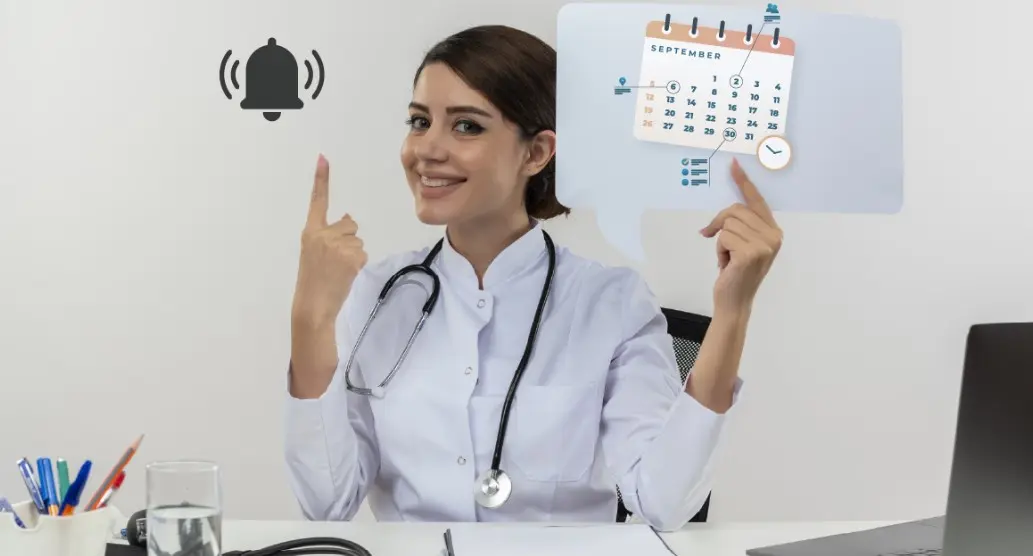No-shows. Late arrivals. Missed follow-ups.
Every healthcare provider has dealt with these scheduling hiccups, and they’re more than just minor annoyances. They disrupt daily operations, reduce clinic revenue, and delay patient care. One solution that’s proven both simple and effective? A good patient appointment reminder system—especially one that meets patients where they already are: on their phones.
The No-Show Problem (and Why It Keeps Happening)
Studies have shown that no-show rates in outpatient settings can range from 5% to over 30%, depending on specialty and location. For a busy practice, that can translate to thousands of dollars in lost revenue each month—not to mention delays in care for other patients.
And here’s the thing: most patients aren’t skipping appointments maliciously. They’re busy. They forget. They mix up at times. They didn’t see the email. Or they just never got a reminder at all.
In a world where people get push notifications for everything—from pizza deliveries to banking transactions—it’s clear that healthcare needs to catch up. Patients expect reminders in real time, on the device they use most.
Why Text-Based Reminders Make Sense
Phone calls go unanswered. Emails get buried. But text messages? They’re open fast. SMS has a 98% open rate, and most messages are read within 3 minutes.
That’s why clinics that switch to text-based reminders often see a dramatic drop in no-shows. Patients receive timely nudges that are hard to ignore, and they’re reminded of the appointment in the format they already prefer.
Text reminders also reduce administrative burden. No more calling a list of patients every morning. No more wondering if messages went to voicemail. Automation takes care of it, freeing up your team to focus on more valuable work—like greeting patients, answering questions, and solving urgent problems.
The Right Message at the Right Time
Of course, not all reminders are equally effective. The best systems follow a few smart rules to ensure patients not only receive reminders but also act on them. A well-designed reminder system will:
- Send alerts at multiple intervals, such as 48 hours and 1 hour before the appointment.
- Include the exact date, time, and location to eliminate confusion.
- Provide a quick response option to confirm, reschedule, or cancel.
- Be personalized enough to feel human, not robotic or spammy.
Patients should be able to reply “YES” to confirm or click a link to adjust the appointment without jumping through hoops. These small conveniences go a long way in creating a smoother, more modern experience.
Compliance Still Matters
Now let’s talk compliance.
Just because texting is easy and popular doesn’t mean you can use just any platform. Healthcare messages—even appointment reminders—must follow HIPAA regulations, especially if they include identifiable patient details like names, appointment types, or office locations.
This is where using a healthcare-specific, HIPAA-compliant system like Curogram becomes essential. Generic SMS tools may work technically, but they put your practice at risk of non-compliance, which can mean fines, legal exposure, and loss of patient trust.
A compliant reminder system ensures encryption, secure opt-ins, audit-friendly logs, and all the safeguards necessary to protect both your clinic and your patients. That’s non-negotiable in modern healthcare.
More Than Just Reducing No-Shows
While reducing missed appointments is the most obvious benefit of reminder systems, there are plenty of other positive outcomes worth mentioning:
- Better patient preparation: Patients are more likely to arrive on time and with necessary documents, ID, or pre-appointment instructions (like fasting or bringing insurance cards).
- Smoother daily flow: Fewer gaps and delays mean that your schedule stays on track, reducing stress for staff and doctors alike.
- Higher patient satisfaction: When patients feel informed and remembered, their perception of care improves—even before they step into the office.
- Efficient rescheduling: If someone can’t make it, a responsive reminder system makes it easier to adjust quickly and fill open slots.
You’re not just reducing no-shows—you’re optimizing your entire appointment pipeline. And the best part? These improvements scale effortlessly across multiple providers, locations, and specialties.
Making the Shift
If you’re worried about the tech side of implementing reminders, rest easy. Most modern solutions are cloud-based and designed to plug directly into your existing EHR or scheduling software. Setup is often completed in just a few days, not weeks.
Patients don’t need to download any app or learn anything new. They simply receive messages directly on their phones—the same way they receive texts from friends, family, or food couriers. It’s a frictionless transition.
The real key is to choose a platform that offers both automation and flexibility. You want to reduce the manual work, yes—but also retain the ability to customize timing, tone, and message content to fit your practice’s voice and workflows.
Once it’s up and running, you’ll wonder how your team ever managed without it. Staff will spend less time making calls and more time helping patients. And you’ll likely see immediate improvements in attendance, satisfaction, and revenue.
Final Thoughts
Appointment reminders are more than just a logistical tool—they’re a bridge between your practice and your patients. In a digital world where everyone is juggling a hundred things, a simple, timely text can make all the difference.
Done right, reminders improve outcomes for everyone: patients stay on track, staff stay organized, and providers see fewer empty chairs. It’s one of the rare tools that offers convenience, compliance, and cost-effectiveness in one package.
So if your clinic is still relying on manual calls or generic reminder systems, now’s the time to upgrade. Look for a HIPAA-compliant solution built for healthcare. The results will speak for themselves.
Further Reading: Curious how behavioral science supports the effectiveness of reminders? The American Psychological Association discusses how timely and well-structured communication helps people follow through on important tasks, including appointments.
Behavioral research shows that people are more likely to act on reminders when they receive them at key decision points, like the night before or the morning of an appointment. The more relevant, specific, and actionable the message, the higher the success rate. This insight reinforces why thoughtful timing and content design in reminder systems can directly improve attendance and follow-through in clinical settings.
By incorporating these psychology-backed principles into your communication strategy, you’re not just sending messages—you’re influencing positive behavior change.
Also read-Longevity Supplements: Enhancing Healthspan and Lifespan through Science










